NRSG140: Reflective Report on Oral Medication Administration
VerifiedAdded on 2022/10/02
|5
|1201
|17
Report
AI Summary
This report is a reflective analysis of a nursing student's experience administering oral medication in a classroom setting, guided by the Gibbs reflective model. The student details the practical process, including patient identification, medication verification, and adherence to the seven rights of medication administration. The report explores the student's feelings of nervousness and self-consciousness, as well as the positive aspects of the experience, such as remembering classroom teachings and gaining confidence. The evaluation section highlights both successes, like following procedures, and areas for improvement, such as calculating dosages and recalling medication charts. The analysis emphasizes the importance of patient-centered care, the seven rights of drug administration, and the clinical reasoning cycle. The conclusion summarizes the need for teamwork, confidence, and continuous learning. Finally, an action plan outlines steps the student will take to enhance future practice, focusing on creating a friendly environment, following instructions, and improving accuracy and speed.
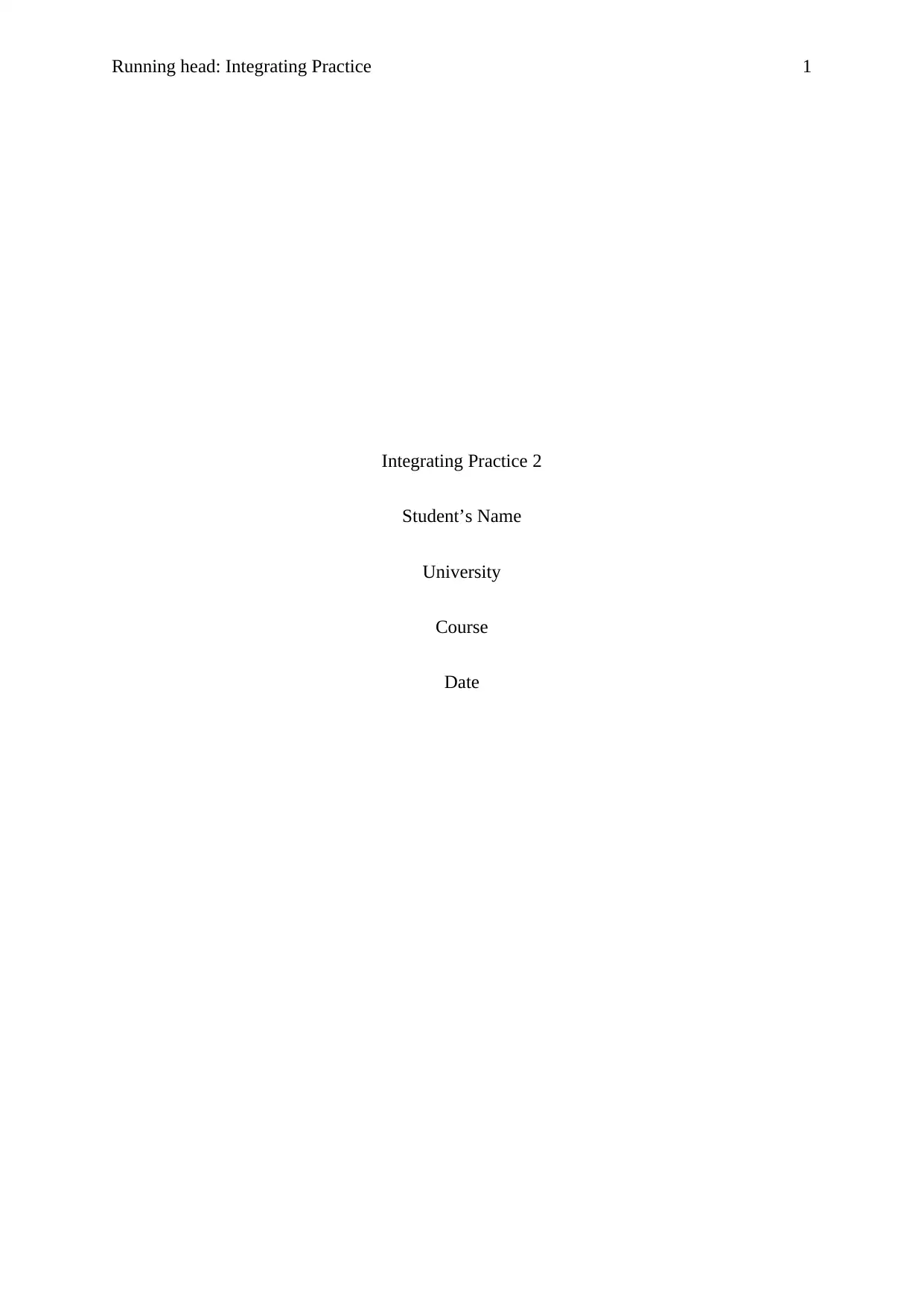
Running head: Integrating Practice 1
Integrating Practice 2
Student’s Name
University
Course
Date
Integrating Practice 2
Student’s Name
University
Course
Date
Paraphrase This Document
Need a fresh take? Get an instant paraphrase of this document with our AI Paraphraser
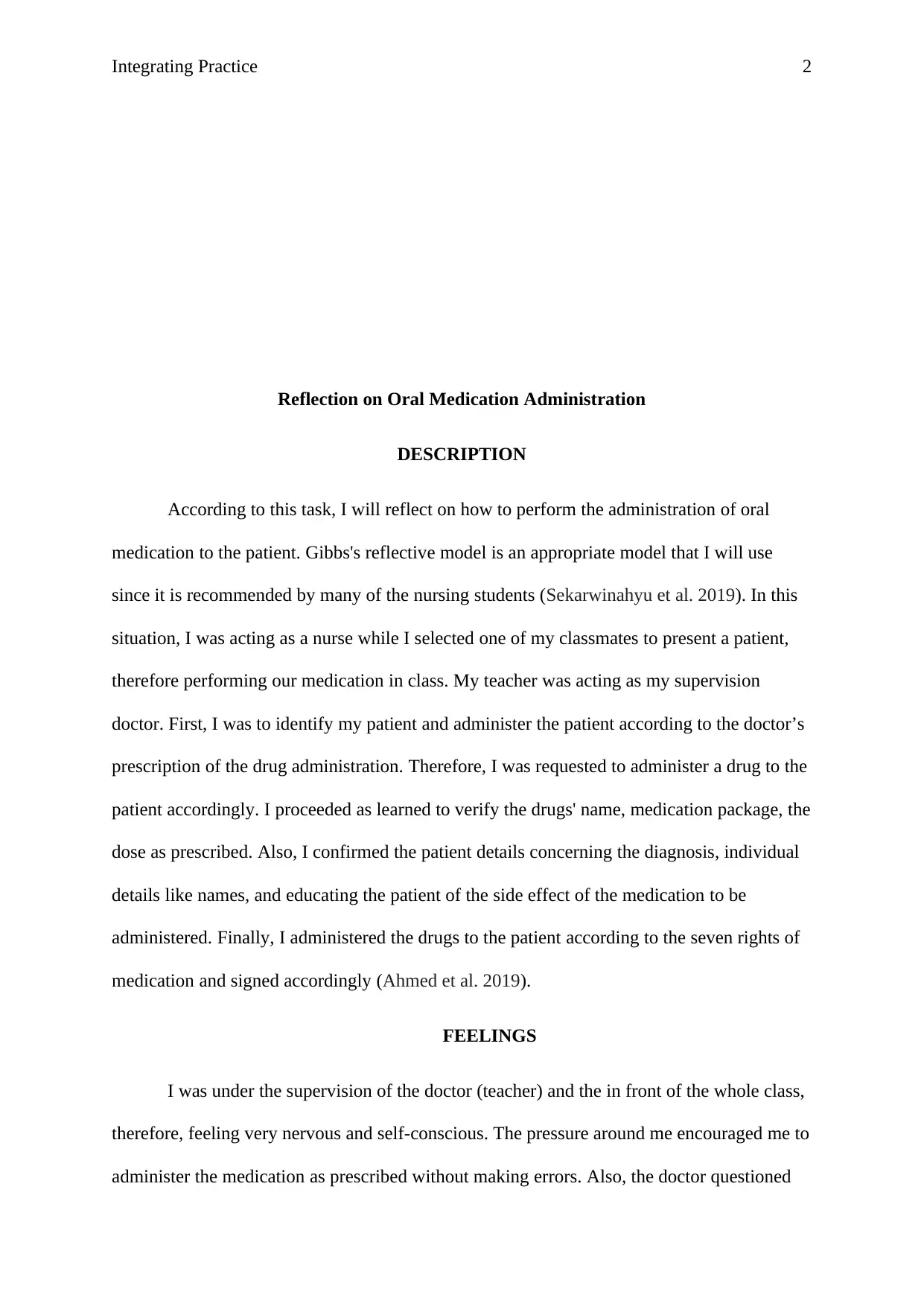
Integrating Practice 2
Reflection on Oral Medication Administration
DESCRIPTION
According to this task, I will reflect on how to perform the administration of oral
medication to the patient. Gibbs's reflective model is an appropriate model that I will use
since it is recommended by many of the nursing students (Sekarwinahyu et al. 2019). In this
situation, I was acting as a nurse while I selected one of my classmates to present a patient,
therefore performing our medication in class. My teacher was acting as my supervision
doctor. First, I was to identify my patient and administer the patient according to the doctor’s
prescription of the drug administration. Therefore, I was requested to administer a drug to the
patient accordingly. I proceeded as learned to verify the drugs' name, medication package, the
dose as prescribed. Also, I confirmed the patient details concerning the diagnosis, individual
details like names, and educating the patient of the side effect of the medication to be
administered. Finally, I administered the drugs to the patient according to the seven rights of
medication and signed accordingly (Ahmed et al. 2019).
FEELINGS
I was under the supervision of the doctor (teacher) and the in front of the whole class,
therefore, feeling very nervous and self-conscious. The pressure around me encouraged me to
administer the medication as prescribed without making errors. Also, the doctor questioned
Reflection on Oral Medication Administration
DESCRIPTION
According to this task, I will reflect on how to perform the administration of oral
medication to the patient. Gibbs's reflective model is an appropriate model that I will use
since it is recommended by many of the nursing students (Sekarwinahyu et al. 2019). In this
situation, I was acting as a nurse while I selected one of my classmates to present a patient,
therefore performing our medication in class. My teacher was acting as my supervision
doctor. First, I was to identify my patient and administer the patient according to the doctor’s
prescription of the drug administration. Therefore, I was requested to administer a drug to the
patient accordingly. I proceeded as learned to verify the drugs' name, medication package, the
dose as prescribed. Also, I confirmed the patient details concerning the diagnosis, individual
details like names, and educating the patient of the side effect of the medication to be
administered. Finally, I administered the drugs to the patient according to the seven rights of
medication and signed accordingly (Ahmed et al. 2019).
FEELINGS
I was under the supervision of the doctor (teacher) and the in front of the whole class,
therefore, feeling very nervous and self-conscious. The pressure around me encouraged me to
administer the medication as prescribed without making errors. Also, the doctor questioned
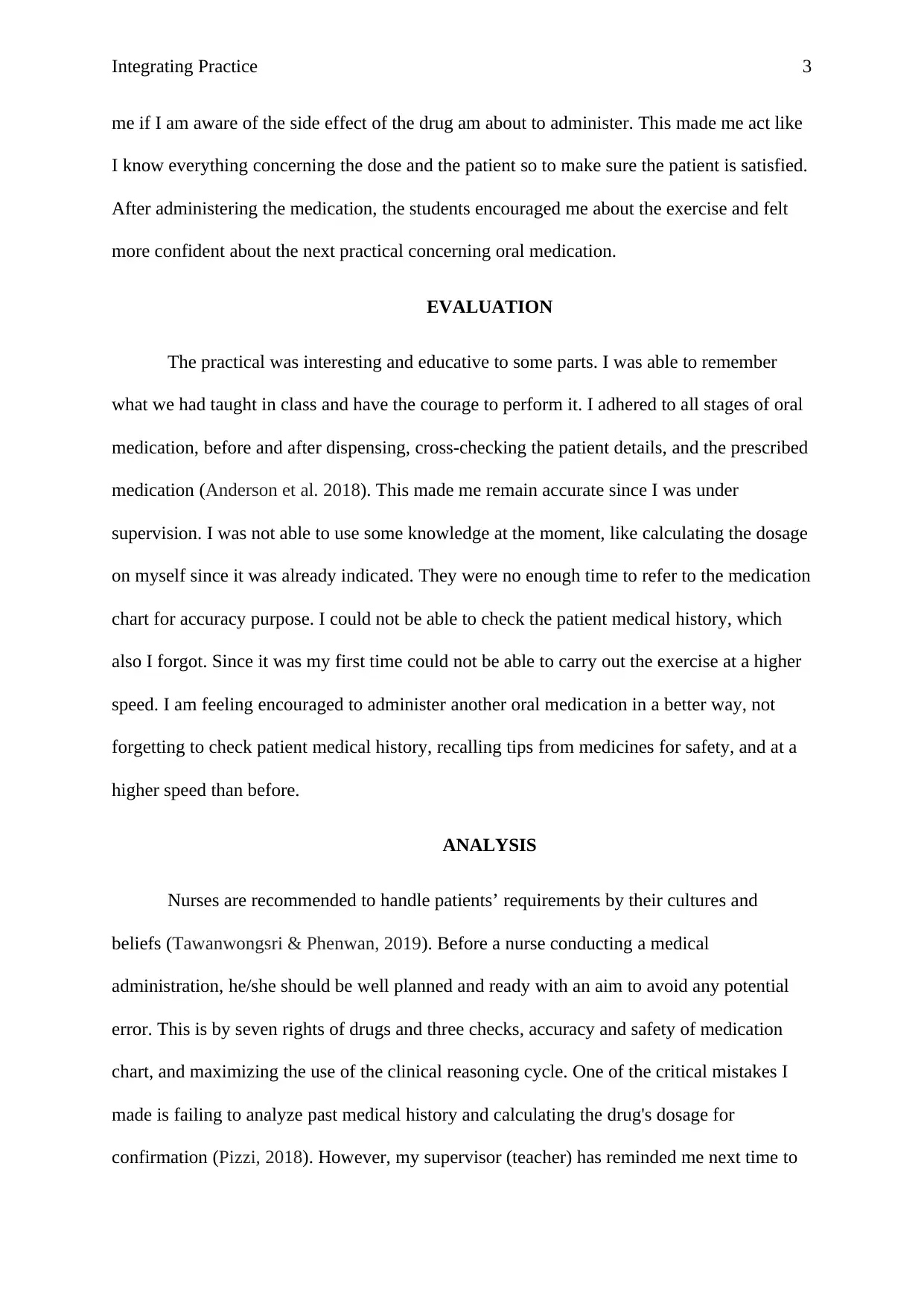
Integrating Practice 3
me if I am aware of the side effect of the drug am about to administer. This made me act like
I know everything concerning the dose and the patient so to make sure the patient is satisfied.
After administering the medication, the students encouraged me about the exercise and felt
more confident about the next practical concerning oral medication.
EVALUATION
The practical was interesting and educative to some parts. I was able to remember
what we had taught in class and have the courage to perform it. I adhered to all stages of oral
medication, before and after dispensing, cross-checking the patient details, and the prescribed
medication (Anderson et al. 2018). This made me remain accurate since I was under
supervision. I was not able to use some knowledge at the moment, like calculating the dosage
on myself since it was already indicated. They were no enough time to refer to the medication
chart for accuracy purpose. I could not be able to check the patient medical history, which
also I forgot. Since it was my first time could not be able to carry out the exercise at a higher
speed. I am feeling encouraged to administer another oral medication in a better way, not
forgetting to check patient medical history, recalling tips from medicines for safety, and at a
higher speed than before.
ANALYSIS
Nurses are recommended to handle patients’ requirements by their cultures and
beliefs (Tawanwongsri & Phenwan, 2019). Before a nurse conducting a medical
administration, he/she should be well planned and ready with an aim to avoid any potential
error. This is by seven rights of drugs and three checks, accuracy and safety of medication
chart, and maximizing the use of the clinical reasoning cycle. One of the critical mistakes I
made is failing to analyze past medical history and calculating the drug's dosage for
confirmation (Pizzi, 2018). However, my supervisor (teacher) has reminded me next time to
me if I am aware of the side effect of the drug am about to administer. This made me act like
I know everything concerning the dose and the patient so to make sure the patient is satisfied.
After administering the medication, the students encouraged me about the exercise and felt
more confident about the next practical concerning oral medication.
EVALUATION
The practical was interesting and educative to some parts. I was able to remember
what we had taught in class and have the courage to perform it. I adhered to all stages of oral
medication, before and after dispensing, cross-checking the patient details, and the prescribed
medication (Anderson et al. 2018). This made me remain accurate since I was under
supervision. I was not able to use some knowledge at the moment, like calculating the dosage
on myself since it was already indicated. They were no enough time to refer to the medication
chart for accuracy purpose. I could not be able to check the patient medical history, which
also I forgot. Since it was my first time could not be able to carry out the exercise at a higher
speed. I am feeling encouraged to administer another oral medication in a better way, not
forgetting to check patient medical history, recalling tips from medicines for safety, and at a
higher speed than before.
ANALYSIS
Nurses are recommended to handle patients’ requirements by their cultures and
beliefs (Tawanwongsri & Phenwan, 2019). Before a nurse conducting a medical
administration, he/she should be well planned and ready with an aim to avoid any potential
error. This is by seven rights of drugs and three checks, accuracy and safety of medication
chart, and maximizing the use of the clinical reasoning cycle. One of the critical mistakes I
made is failing to analyze past medical history and calculating the drug's dosage for
confirmation (Pizzi, 2018). However, my supervisor (teacher) has reminded me next time to
⊘ This is a preview!⊘
Do you want full access?
Subscribe today to unlock all pages.

Trusted by 1+ million students worldwide
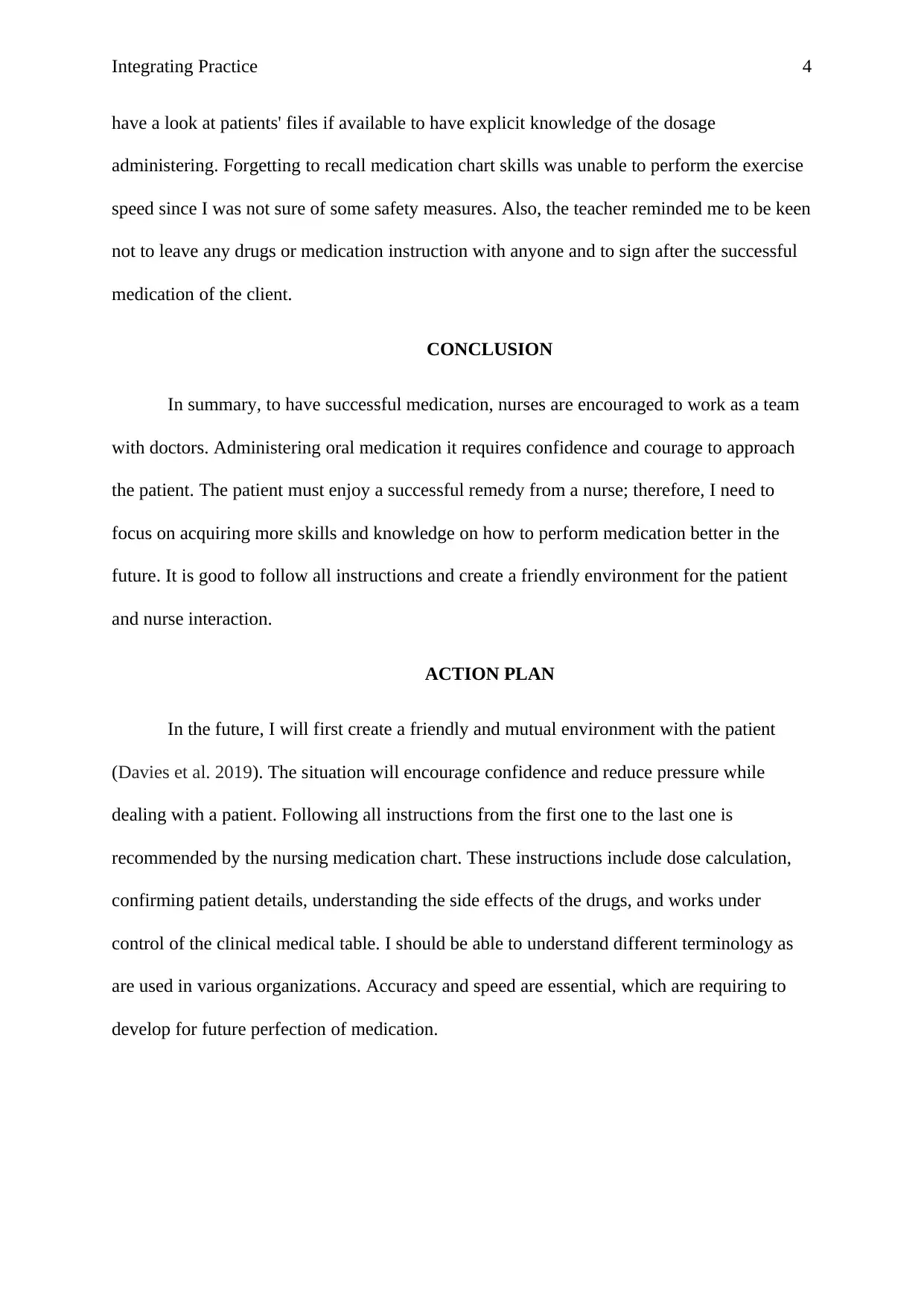
Integrating Practice 4
have a look at patients' files if available to have explicit knowledge of the dosage
administering. Forgetting to recall medication chart skills was unable to perform the exercise
speed since I was not sure of some safety measures. Also, the teacher reminded me to be keen
not to leave any drugs or medication instruction with anyone and to sign after the successful
medication of the client.
CONCLUSION
In summary, to have successful medication, nurses are encouraged to work as a team
with doctors. Administering oral medication it requires confidence and courage to approach
the patient. The patient must enjoy a successful remedy from a nurse; therefore, I need to
focus on acquiring more skills and knowledge on how to perform medication better in the
future. It is good to follow all instructions and create a friendly environment for the patient
and nurse interaction.
ACTION PLAN
In the future, I will first create a friendly and mutual environment with the patient
(Davies et al. 2019). The situation will encourage confidence and reduce pressure while
dealing with a patient. Following all instructions from the first one to the last one is
recommended by the nursing medication chart. These instructions include dose calculation,
confirming patient details, understanding the side effects of the drugs, and works under
control of the clinical medical table. I should be able to understand different terminology as
are used in various organizations. Accuracy and speed are essential, which are requiring to
develop for future perfection of medication.
have a look at patients' files if available to have explicit knowledge of the dosage
administering. Forgetting to recall medication chart skills was unable to perform the exercise
speed since I was not sure of some safety measures. Also, the teacher reminded me to be keen
not to leave any drugs or medication instruction with anyone and to sign after the successful
medication of the client.
CONCLUSION
In summary, to have successful medication, nurses are encouraged to work as a team
with doctors. Administering oral medication it requires confidence and courage to approach
the patient. The patient must enjoy a successful remedy from a nurse; therefore, I need to
focus on acquiring more skills and knowledge on how to perform medication better in the
future. It is good to follow all instructions and create a friendly environment for the patient
and nurse interaction.
ACTION PLAN
In the future, I will first create a friendly and mutual environment with the patient
(Davies et al. 2019). The situation will encourage confidence and reduce pressure while
dealing with a patient. Following all instructions from the first one to the last one is
recommended by the nursing medication chart. These instructions include dose calculation,
confirming patient details, understanding the side effects of the drugs, and works under
control of the clinical medical table. I should be able to understand different terminology as
are used in various organizations. Accuracy and speed are essential, which are requiring to
develop for future perfection of medication.
Paraphrase This Document
Need a fresh take? Get an instant paraphrase of this document with our AI Paraphraser
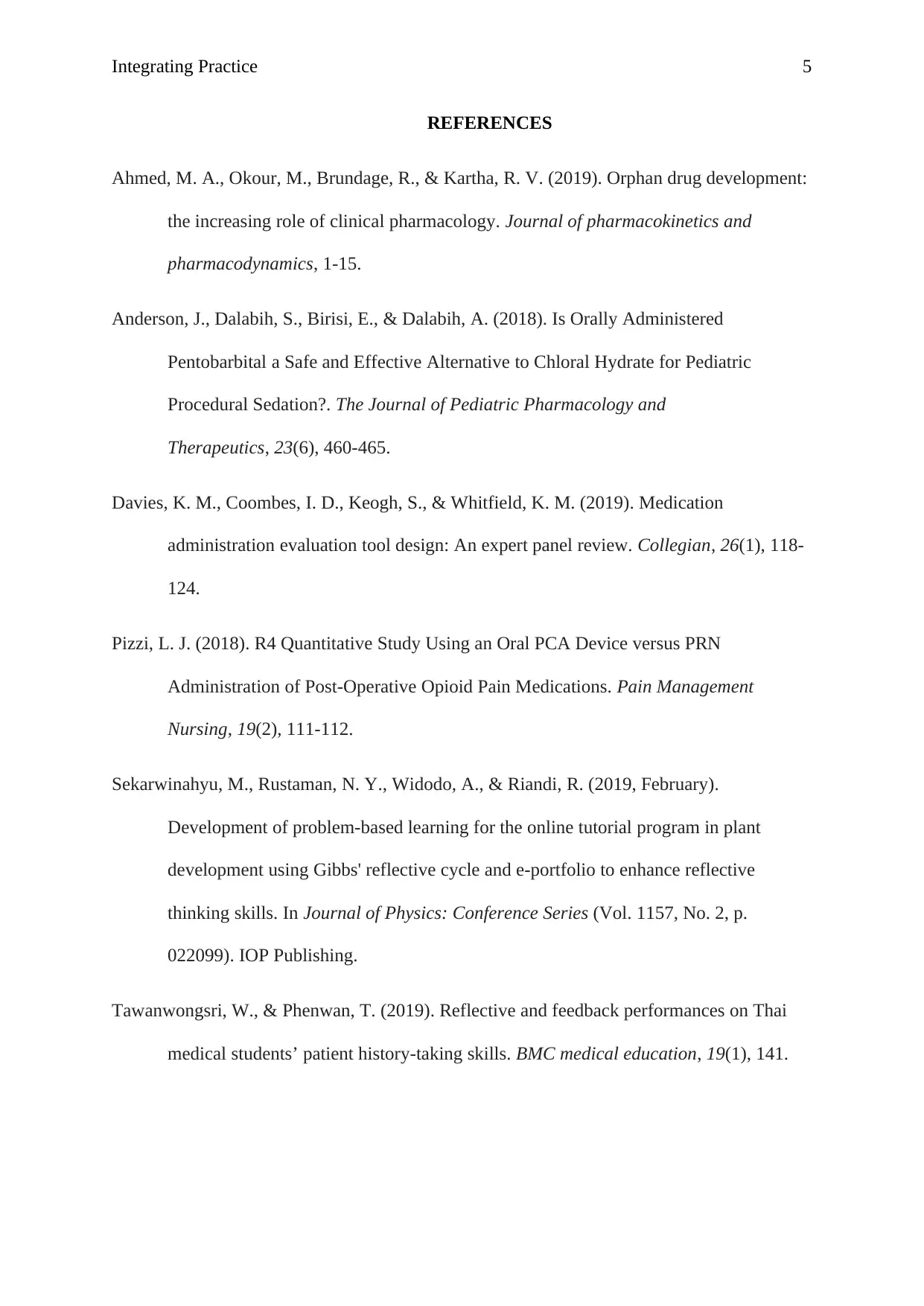
Integrating Practice 5
REFERENCES
Ahmed, M. A., Okour, M., Brundage, R., & Kartha, R. V. (2019). Orphan drug development:
the increasing role of clinical pharmacology. Journal of pharmacokinetics and
pharmacodynamics, 1-15.
Anderson, J., Dalabih, S., Birisi, E., & Dalabih, A. (2018). Is Orally Administered
Pentobarbital a Safe and Effective Alternative to Chloral Hydrate for Pediatric
Procedural Sedation?. The Journal of Pediatric Pharmacology and
Therapeutics, 23(6), 460-465.
Davies, K. M., Coombes, I. D., Keogh, S., & Whitfield, K. M. (2019). Medication
administration evaluation tool design: An expert panel review. Collegian, 26(1), 118-
124.
Pizzi, L. J. (2018). R4 Quantitative Study Using an Oral PCA Device versus PRN
Administration of Post-Operative Opioid Pain Medications. Pain Management
Nursing, 19(2), 111-112.
Sekarwinahyu, M., Rustaman, N. Y., Widodo, A., & Riandi, R. (2019, February).
Development of problem-based learning for the online tutorial program in plant
development using Gibbs' reflective cycle and e-portfolio to enhance reflective
thinking skills. In Journal of Physics: Conference Series (Vol. 1157, No. 2, p.
022099). IOP Publishing.
Tawanwongsri, W., & Phenwan, T. (2019). Reflective and feedback performances on Thai
medical students’ patient history-taking skills. BMC medical education, 19(1), 141.
REFERENCES
Ahmed, M. A., Okour, M., Brundage, R., & Kartha, R. V. (2019). Orphan drug development:
the increasing role of clinical pharmacology. Journal of pharmacokinetics and
pharmacodynamics, 1-15.
Anderson, J., Dalabih, S., Birisi, E., & Dalabih, A. (2018). Is Orally Administered
Pentobarbital a Safe and Effective Alternative to Chloral Hydrate for Pediatric
Procedural Sedation?. The Journal of Pediatric Pharmacology and
Therapeutics, 23(6), 460-465.
Davies, K. M., Coombes, I. D., Keogh, S., & Whitfield, K. M. (2019). Medication
administration evaluation tool design: An expert panel review. Collegian, 26(1), 118-
124.
Pizzi, L. J. (2018). R4 Quantitative Study Using an Oral PCA Device versus PRN
Administration of Post-Operative Opioid Pain Medications. Pain Management
Nursing, 19(2), 111-112.
Sekarwinahyu, M., Rustaman, N. Y., Widodo, A., & Riandi, R. (2019, February).
Development of problem-based learning for the online tutorial program in plant
development using Gibbs' reflective cycle and e-portfolio to enhance reflective
thinking skills. In Journal of Physics: Conference Series (Vol. 1157, No. 2, p.
022099). IOP Publishing.
Tawanwongsri, W., & Phenwan, T. (2019). Reflective and feedback performances on Thai
medical students’ patient history-taking skills. BMC medical education, 19(1), 141.
1 out of 5
Related Documents
Your All-in-One AI-Powered Toolkit for Academic Success.
+13062052269
info@desklib.com
Available 24*7 on WhatsApp / Email
![[object Object]](/_next/static/media/star-bottom.7253800d.svg)
Unlock your academic potential
Copyright © 2020–2025 A2Z Services. All Rights Reserved. Developed and managed by ZUCOL.





